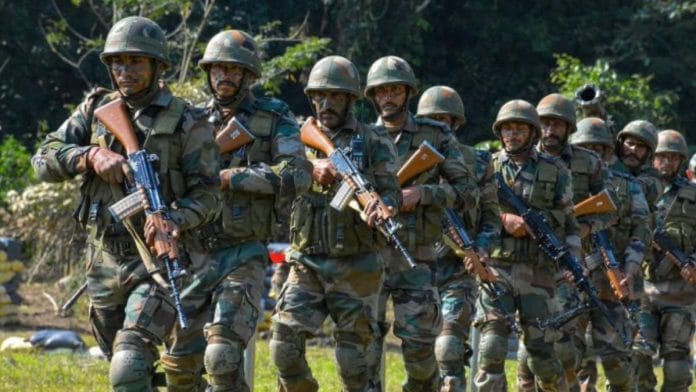The Narendra Modi government’s decision to implement a cross posting policy for the armed forces is a welcome step. Following some truly perplexing policy decisions in the recent past, this is a move in the right direction for promoting jointmanship within the Services.
The policy entails the posting of officers at the functional rank of Major and Lieutenant Colonel, and their Navy and Air Force equivalents, in the other Services. It will certainly foster greater systemic awareness at critical implementation levels within the Services. At a certain stage, this initiative should be taken to its logical end.
Proceed with eagerness
As it stands, the policy involves posting officers for tasks that are similar to the soldiers’ current duties. So, a naval missile officer will be posted to an Air Force squadron focused on missiles. And an Army officer from an unmanned aerial vehicle (UAV) unit would be posted to a naval appointment performing the same role. The logistics sector would probably see the largest number of such cross postings, for the Services have opened up this corps, and none of the armed forces likes to let go of anyone directly connected to combat roles. Nonetheless, there is a need to do that.
In terms of the future of armed forces integration, and the long-announced theatre commands, this is an important but tentative step. The numbers involved are minuscule thus far, and, therefore, unlikely to ruffle any empire building feathers—the bugbear of all things military. It sets up the stage for furthering the process of integration, and it must proceed with utmost eagerness. The first steps are always the most important, and so is the decision to begin with logistics cross postings. This is the aspect of soldiering that doesn’t garner the attention it deserves but is the most important.
The Modi government could well set up a logistics command, for such is the importance of this corps. And given the current penchant to surreptitiously cut back armed forces numbers and capital investments, a tri-Service logistics corps, and its corresponding command, can actually save a lot of money for better budgeting. It could start with the cross posting of officers, for they could create the working environment to take the next steps for raising a joint logistics corps, furthering confidence within the military fraternity. And that is, after all, the purpose of cross postings.
Also read: Rajnath Singh wants Indian military to boost R&D. But defence finance is complex territory
Plug the gaps in air defence
Another aspect of soldiering that doesn’t get the importance it deserves, and has critical operational shortcomings, is air defence. The three Services maintain their independent air defence corps, and their integration is vitally important. Each Service knows the lacunae that exist and would greatly benefit from greater tri-Service postings in this sector. And technically related to this, but coming from a completely different perspective, is the greater interaction between the three separate signals corps. After all, air defence needs excellent and secure communication to fulfil its tasks fully. And that can best come from a truly integrated signal officer cadre.
The next step is to take the process forward to joint operational planning stages. And that would ideally be done by posting officers into the perspective planning directorates at first, following which the bar can quite easily be raised. Naval and Air Force officers posted as Deputy Chiefs of Strategy at Army Headquarters will certainly be value additions. Once perspectives begin to match, and jointness appears more benign than it was made out to be, it will be a matter of time before officers are in joint operations rooms. That is the ultimate indicator of integration.
Planning and execution of operations is obviously the desired end state, for then the armed forces can be said to have achieved jointmanship. The purpose of all military endeavour is, after all, to efficiently plan and execute operational directives that have been received. All of that is only possible once the ultimate military weapon is safely shared by the three Services — and that is the Annual Confidential Report (ACR), the piece of paper that does more to make or break a career than well-executed operations. Once the Services respect and implement each others’ ACRs, the last hurdle will be crossed.
Hardware, workforce important too
The workforce crisis that the three Services face today is of deep concern. While the issue is a matter of greater national scrutiny, the long-term outcome is that the armed forces are going to be asked to do a lot more with a lot less. And that less is in terms of both workforce and hardware. This is today’s sad reality where lofty buildings are more important than a third aircraft carrier, modern submarines, and a viable number of combat aircraft.
When defence pensions are of greater concern than the workforce to protect borders, matters will boil over.
With China refusing to vacate occupied territories, increased workforce shortage is only going to cause deeper trouble for India. And now that fires have been lit in Manipur, they are not going to subside for a while, further dragging the Army into additional internal security duties there. Enhanced inter-Service cooperation is the only way to overcome these crises appearing on the horizon. Cross postings is a positive step to inculcate that spirit of cooperation.
Manvendra Singh is a Congress leader, Editor-in-Chief of Defence & Security Alert and Chairman, Soldier Welfare Advisory Committee, Rajasthan. He tweets @ManvendraJasol. Views are personal.
(Edited by Humra Laeeq)






